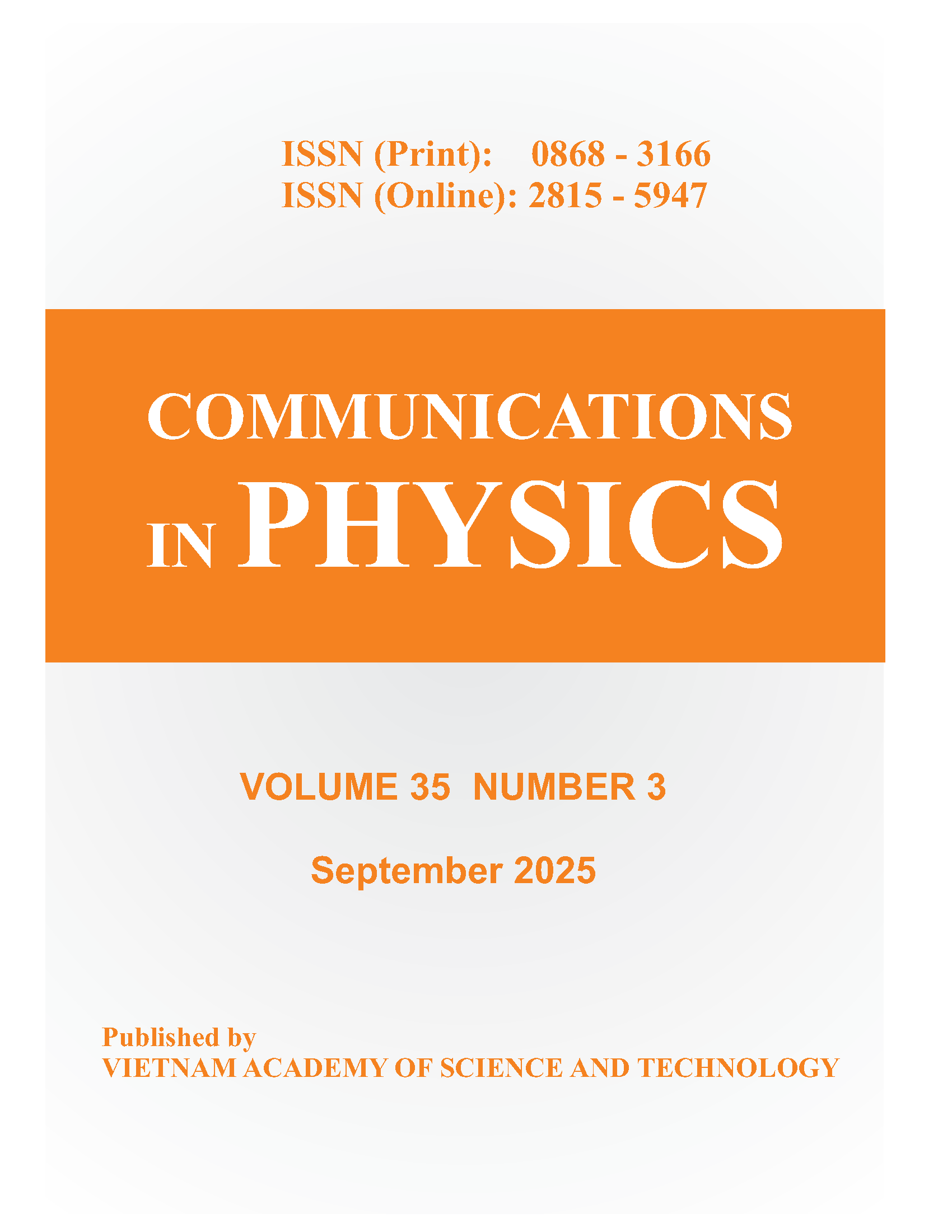Germanium Band Gap Engineering Induced by Tensile Strain for Si-Based Optoelectronic Applications
Author affiliations
DOI:
https://doi.org/10.15625/0868-3166/23/4/3207Keywords:
tensile strain, optoelectronics, molecular beam epitaxy, cyclic annealingAbstract
We have combined structural and optical characterizations to investigate the tensile-strained state and the band gap engineering of Ge layers grown on Si(001) using molecular beam epitaxy. The tensile strain is generated in the Ge layers due to a difference of thermal expansion coefficients between Ge and Si. The Ge growth on Si(001) was proceeded using a two-step growth process: a low-temperature step to produce relaxed buffer layers, followed by a high-temperature step to generate the tensile strain in the Ge layers. For the low-temperature step, we have evidenced the existence of a substrate temperature window from 260 to \(300\circ\)C in which the well-known Stranski-Krastanov Ge/Si growth mode transition from two-dimensional to three-dimensional growth can be completely suppressed. We show that the value of the tensile strain in the Ge layers lineally increases with increasing the growth temperature and reaches a saturation value of \(\sim 0.24\)% in the temperature range of \(700-770\circ\)C. Post-grown cyclic thermal annealing has allowed to increase the tensile strain up to 0.30%, which is the highest value ever reported to date. Finally, photoluminescence measurements reveal both an enhancement of the Ge direct band gap emission and a reduction of its energy due to the presence of tensile strain in the layers.Downloads
References
J. Liu, X. Sun, R. Camacho-Aguilera, L. C. Kimerling, and J. Michel, Opt. Lett. 35 (2010) 679 and references therein.
R. Soref, J. Kouvetakis, and J. Menendez, Mater. Res. Soc. Symp. Proc. 958 (2007) 13.
R. Soref, J. Kouvetakis, J. Tolle, J. Menendez, and V. D’Costa, J. Mater. Res. 22 (2007) 3281.
M. El Kurdi, G. Fishman, S. Sauvage, and P. Boucaud, J. Appl. Phys. 107 (2010) 013710.
X. Sun, J.F. Liu, L.C. Kimerling, J. Michel, Appl. Phys. Lett. 95 (2009) 011911.
M. El Kurdi, T. Kociniewski, T.-P. Ngo, J. Boulmer, D. Débarre, P. Boucaud, J.F. Damlencourt, O. Kermarrec, and D. Bensahel, Appl. Phys. Lett. 94 (2009) 191107.
M. El Kurdi, H. Bertin, E. Martincic, M. de Kersauson, G. Fishman, S. Sauvage, A. Bosseboeuf, and P. Boucaud, Appl. Phys. Lett. 96 (2010) 041909.
Y. Bai, K. E. Lee, C. Cheng, M. L. Lee, and E. A. Fitzgerald, J. Appl. Phys. 104 (2008) 084518.
Y.-Y. Fang, J. Tolle, R. Roucka, A.V.G. Chizmeshya, J. Kouvetakis, V.R. D'Costa, J. Menéndez, Appl. Phys. Lett. 90, 061915 (2007); J. Menëndez, J. Kouvetakis, Appl. Phys. Lett. 85 (2004) 1175.
D.J. Eaglesham, M. Cerullo, Phys. Rev. Lett. 64 (1990) 1943.
V. Le Thanh, Surf. Sci. 492 (2001) 255 and references therein.
L. Colace, G. Masini, F. Galluzzi, G. Assanto, G. Capellini, L. Di Gaspare, E. Pelange, and F. Evangelisti, Appl. Phys. Lett. 72 (1998) 3175.
H.-C. Luan, D.R. Lim, K.K. Lee, K.M. Chen, J.G. Sandland, K. Wada, L.C. Kimerling, Appl. Phys. Lett. 75 (1999) 2009.
J.-M. Hartmann, A. Abbadie, A.M. Papon, P. Holliger, G. Rolland, T. Billon, J.M. Fédéli, M. Rouvière, L. Vivien, S. Laval, J. Appl. Phys. 95 (2004) 5905.
J.-M. Hartmann, A.M. Papon, V. Destefanis, T. Billon, J. Cryst. Growth. 310 (2008) 5287.
V. Le Thanh, V. Aubry-Fortuna, D. Bouchier, A. Younsi, and G. Hincelin, Surf. Sci. 369 (1996) 85.
M. Halbwax, D. Bouchier, V. Yam, D. Débarre, Lam H. Nguyen, Y. Zheng, P. Rosner, M. Benamara, H. P. Strunk, C. Clerc, J. Appl. Phys. 97 (2005) 064907.
V. Le Thanh, D. Bouchier, G. Hincelin, J. Appl. Phys. 87 (2000) 3700.
J. Liu, H. J. Kim, O. Hul’ko, Y. H. Xie, S. Sahni, P. Bandaru, and E. Yablonovitch, J. Appl. Phys. 96 (2004) 916.
J. Liu, D. D. Cannon, Y. Ishikawa, K. Wada, D. T. Danielson, S. Jongthammanurak, J. Michel, and L. C. Kimerling, Phys. Rev. B. 70 (2004) 155309.
L. Souriau, T. Atanasova, V. Terzieva, A. Moussa, M. Caymax, R. Loo, M. Meuris, and W. Vandervorst, J. Chem. Soc. 155 (2008) H677.
M. A. Lutz, R. M. Feenstra, F. K. LeGoues, P. M. Mooney, and J. O. Chu, Appl. Phys. Lett. 66 (1995) 724.
Downloads
Published
How to Cite
Issue
Section
License
Communications in Physics is licensed under a Creative Commons Attribution-ShareAlike 4.0 International License.
Copyright on any research article published in Communications in Physics is retained by the respective author(s), without restrictions. Authors grant VAST Journals System (VJS) a license to publish the article and identify itself as the original publisher. Upon author(s) by giving permission to Communications in Physics either via Communications in Physics portal or other channel to publish their research work in Communications in Physics agrees to all the terms and conditions of https://creativecommons.org/licenses/by-sa/4.0/ License and terms & condition set by VJS.











